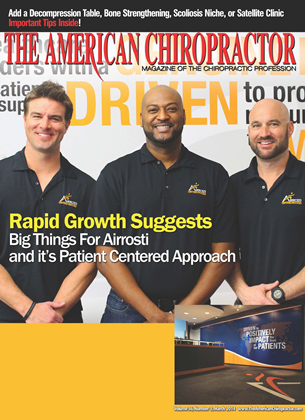History and Presenting Symptoms A 17-year-old male high school student presents with aching pain and tightness in his right lower leg. As an outfielder on his school"s baseball team, he describes a collision injury during a game four days earlier, which resulted in pain and bruising in the front of his right leg after sliding into second base. Despite repeated icing, the area still feels swollen. He describes this as "shin splints." Exam Findings Vitals. This young athlete weighs 152 lbs, which at 5" 11"" results in a BMI of 21. so he is not overweight. He is a nonsniokcr. and his blood pressure and pulse rate are both at the lower end of normal range. Posture and gait. Standing postural evaluation finds good alignment in general throughout his spine and pelvis with normal spinal curves and no lateral curvature or listing. His knees and ankles are also well aligned with no knee valgus or varus and no calcancal eversion or foot flare. Both medial arches are somewhat high, and gait evaluation reveals excessive siipination with insufficient pronation. Chiropractic evaluation. Motion palpation and joint play analysis identifies a mild limitation in lumbosacral motion with moderate tenderness and loss of end-range mobility at the right of L4/L5. Primary complaint. Examination of the right lower leg finds moderate tenderness and tightness along the anterior tibialis musculature. There is apparent loss of sharp sensation discrimination in the lateral aspect of the foot, but no numbness orparcsthesia. The right foot intrinsic muscles demonstrate no weakness, and he has no difficulty performing toe extension. All ankle ranges of motion are full and pain-free, but inversion is limited by the tightness of the anterior tibialis muscle. The right cuboid is tender to palpation and demonstrates a lateral fixation. Imaging No x-rays or other forms of musculoskelctal imaging were requested. Clinical Impression Anterior compartment syndrome in the right lower leg associated with mild neurological compression. Treatment Plan Adjustments. Specific, corrective adjustments for the lumbar spine and right cuboid were provided as needed. Support. Individually designed stabilizing orthotics were provided to support the high arches and decrease the shock stress on the legs and spine from excessive supination. Rehabilitation. Initially, frequent PNF stretching followed by icing treatments was performed to lengthen and relax the anterior tibialis musculature. As improvement was noted, isotonic resistance exercising in inversion activated and strengthened the antagonists of the anterior tibialis muscle. Finally, a comprehensive strengthening program using exercise tubing prepared him for a return to full athletic participation. Response to Care The stretches and adjustments were well tolerated, and he reported a decrease in symptoms within the first 24 hours. After two weeks of care, he was able to return to practice, including light running. He responded well to the orthotics and was released to a self-directed home stretching program after a total of eight treatment sessions over two months. Discussion The commonly used term "shin splints" describes lower leg pain in a nonspecific manner. Several conditions can produce pain in this area, and must be differentiated for effective treatment. High arches and insufficient pronation may predispose athletes to the development of shin splints. While most causes of shin splints arc easily treated with conservative means, anterior compartment syndrome that causes neurological impairment may need to be decompressed surgically. Persistent pain in the lower leg following sports activities may indicate an increase in intramuscular pressure in one of the ostcofascial compartments. Acute trauma can cause the internal pressure of a muscle to elevate excessively during exercise and stay high for a prolonged period postcxcrcisc. While there are five fascial compartments, the anterior compartment is most frequently involved, making the pain area similar to shin splints. Sensory changes arc often evident distally: parcsthesias may involve the first web space, the instep, or the lateral aspect of the foot. If elevated intracompartmcntal pressures persist, permanent damage to muscle tissue and nerves can develop, making early surgical decompression of the involved compartment mandatory. Prompt, conservative care allowed this relatively mild case to be treated without surgery. The stabilizing orthotics provided support and shock absorption during future athletic activities, and no recurrences were reported. Dr. John J. Dancliik. the seventh inductee to the ACA Sports Hall of Fame, is a clinical professor at Tufis University Medical School and formerly chaired the U.S. Olympic Committee s Chiropractic Selection Program. Dr. Dancliik lectures on current trends in sports chiropractic and rehabilitation. He can be reached at [email protected] or 617-489-1220.
 View Full Issue
View Full Issue









